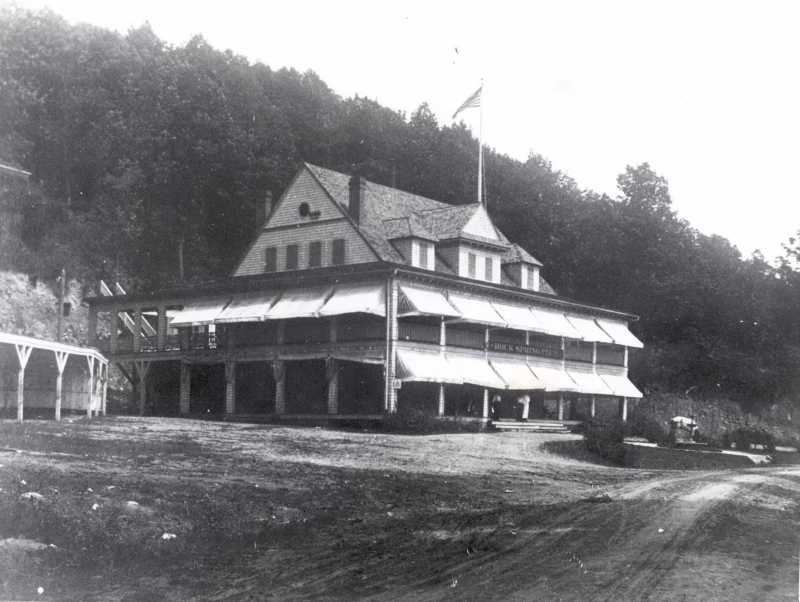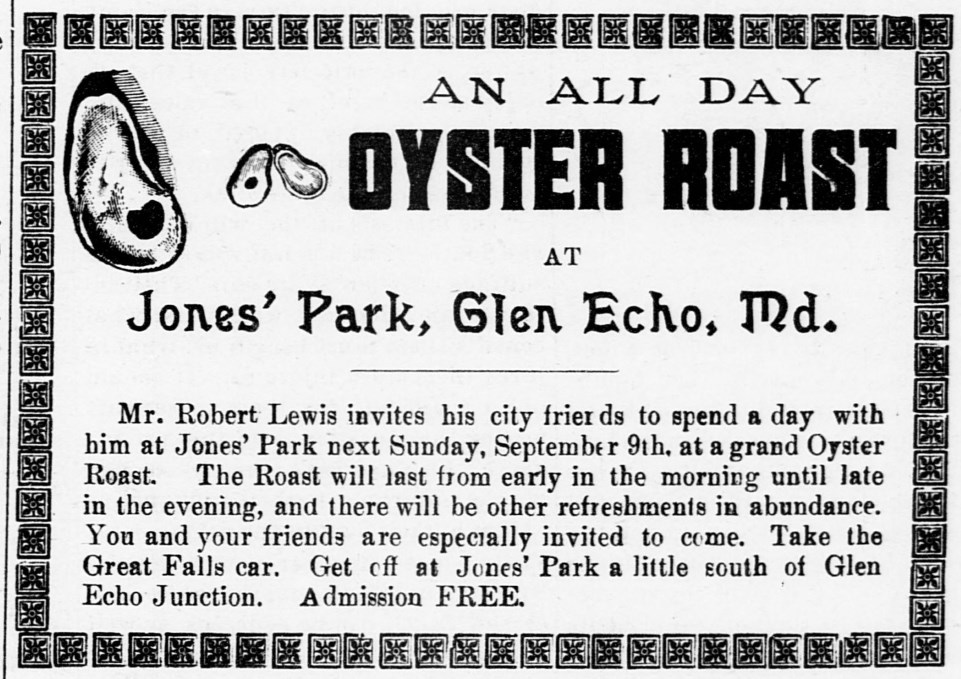Part of a series of articles titled African American Communities Along the C&O Canal.
Article
Rock Spring (Glen Echo Heights), Maryland
A Small Community
The name “Rock Springs” appears as a place or a community on only one map, published in 1917. But a former resident, Frank Dalvert McKinney, recalled in a 1985 interview that “It was a block past the Sycamore Store, on top of the hill. A man named Frank Bock owned about 40 acres in that area and rented houses. I think he owned all of the houses in the Rock Spring community.” 1 McKinney also recalled that the house he rented from Frank Bock in the 1930s cost $10 per month. In the 1910 US census, Frank A. Bock was neighbor to some 20 African American families.![Excerpt of G.M. Hopkins, The Vicinity of Washington, D.C., 1894 [Map] Section of 1894 map showing the location of the Rock Spring Hotel as well as the nearby Potomac River and Glen Echo Heights area.](/articles/images/Maps-for-Rock-Spring_Glen-Echo-article-with-Dates_Resized.jpg?maxwidth=1300&autorotate=false)
Repository: Geography and Map Division, Washington, DC. Library of Congress

Lewis Balsley, photographer; from the collection of Richard Cook. Used with permission from the Collection of Montgomery History.
Mariah M. Gray
The house next to Charles Brill’s belonged to Mariah M. Gray, who was a cook at the Rock Spring Hotel in 1900. Born in North Carolina ca. 1853, probably into slavery, Mariah Gray moved to Montgomery County, Maryland, by 1870. There, she met and married Daniel Gray, with whom she had eight children. Mariah Gray moved between several African American enclaves in the area, from Graysville (named for her husband’s family) on River Road to Gibson Grove in Cabin John and finally to Rock Spring, where she remained until her death. Many other African Americans lived lives like Mariah Gray’s in those years, from enslavement to freedom, and from South to North, as they strove to make lives for themselves and their families.

Library of Congress
Moses Jones and the Jones Hotel
Another neighbor to Mariah Gray was Moses Jones, who was an African American hotel proprietor. From the late 1890s through the early 1900s, Moses Jones advertised the Jones Hotel in Glen Echo to Black Washingtonians in local newspapers with an African American readership, such as The Washington Bee and The Colored American. His early advertisements described his property as wooded and his hotel as a “first-class resort” where meals were served any time.2 The Jones Hotel hosted the local African American chapter of Republicans at least twice according to newspaper notices, suggesting that the hotel was an important gathering place for political Black Washingtonians and African Americans living in lower Montgomery County, Maryland.3
African American leisure and outdoor recreation history remains an important aspect of understanding the pursuit for Civil Rights as it illustrates that even in face of ongoing struggles, African Americans still found ways to enjoy the pleasures of life.
After the Turn of the Century
By the 1920 US census, the Rock Spring area was included within the adjacent Glen Echo Heights neighborhood. It remained an enclave for African Americans who worked in domestic service, including Mariah Gray. Three of the men listed in the census that year reported their occupations as railroad laborers, two as chauffeurs, and several as general laborers. Many of the women took in laundry.
The Rock Spring community didn't survive, however. Its residents were pushed out by the 1930s by the expansion of parks, the construction of the Clara Barton Parkway, and the building of new suburbs that catered to upper- and middle-class White residents in Montgomery County, Maryland.
Information in this article comes from the National Park Service Historic Resource Study: African American Communities Along the Chesapeake & Ohio Canal, by Heather McMahon. Produced by the National Park Service and WSP USA Inc., 2022.
Footnotes
1 Barbara Martin, “Frank D. McKinney: My Heart is in Cabin John,” 1984 (Cabin John, MD: Village News, 1995 (Rockville, MD: Repository, Montgomery History, Jane C. Sween Library). 2.2 “Summer Resorts,” The Washington Bee, 23 July 1898.
3 “Republican Barbecue,” The Washington Bee, 13 September 1902. “Capt. John M. McDonald – The Colored Vote United – Gould Denounced – Paid Negroes Denounced,” The Washington Bee, 23 July 1898.
Sources
- Barbara Martin, “Frank D. McKinney: My Heart is in Cabin John,” 1984 (Cabin John, MD: Village News, 1995 (Rockville, MD: Repository, Montgomery History, Jane C. Sween Library).
- “Capt. John M. McDonald – The Colored Vote United – Gould Denounced – Paid Negroes Denounced,” The Washington Bee, 23 July 1898.
- Patsy Mose Fletcher, Historically African American Destinations Around Washington, DC (Charleston, SC: The History Press, 2015).
- Griffith Morgan Hopkins, Jr. The vicinity of Washington, D.C. Philadelphia: Griffith M. Hopkins, C.E, 1894. Map. Library of Congress, https://www.loc.gov/item/88693364/
- “Republican Barbecue,” The Washington Bee, 13 September 1902.
- “Summer Resorts,” The Washington Bee, 23 July 1898.
- US Geological Survey, Washington and vicinity, Maryland, District of Columbia, Virginia. Washington: Department of Interior, US Geological Survey, 1917. Map. Library of Congress, https://www.loc.gov/item/87691476/.
Tags
- chesapeake & ohio canal national historical park
- national capital region
- national capital area
- ncr
- c&o canal
- choh
- maryland
- montgomery county
- washington d.c.
- district of columbia
- rock spring
- rock springs
- glen echo heights
- history
- african american history
- black history
- civil rights
- recreation
- outdoor recreation
- reconstruction
- reconstruction era
- rock spring club
- moses jones
- jones hotel
- mariah m. gray
- charles arthur brill
- clara barton parkway
Last updated: January 11, 2024
